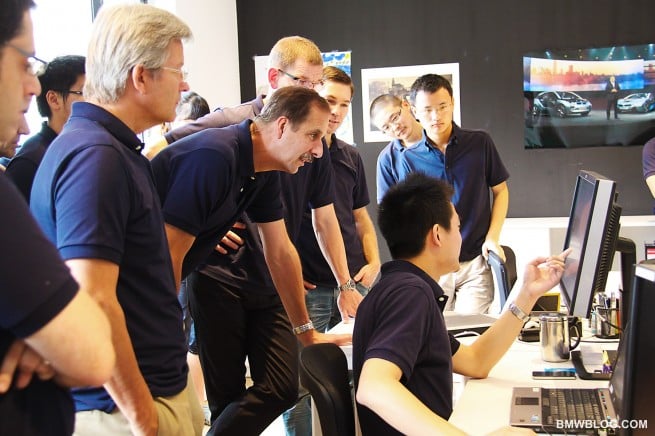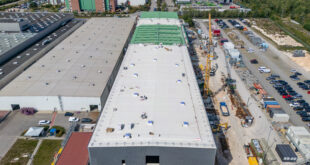 With the introduction of MINI Connected in 2010, the BMW Group became the world’s first carmaker to allow the application-based and extensive integration of the Apple iPhone into its models. Available as an option, MINI Connected links up with a simple USB connection and the MINI Connected App to turn the smartphone into a central interface for infotainment inside, and relating to every aspect of, the car.
With the introduction of MINI Connected in 2010, the BMW Group became the world’s first carmaker to allow the application-based and extensive integration of the Apple iPhone into its models. Available as an option, MINI Connected links up with a simple USB connection and the MINI Connected App to turn the smartphone into a central interface for infotainment inside, and relating to every aspect of, the car.
This technology has provided the launch pad for an all-new in-car infotainment experience. In spring 2011 this interface and app were also made available for BMW vehicles in the form of BMW Apps and BMW Connected. Added to which, the BMW Group has since expanded the app concept to include the internet-based services from BMW Online (available since 2001) and, this summer, also BMW Live. Other compatible apps – and therefore services – from third-party providers can also be integrated into the concept and used in BMW and MINI vehicles.
Scope for rapid and flexible expansion.
With the app concept – using either the application-based integration of a smartphone or a browser inside the vehicle – the BMW Group developers have created a highly flexible and still unrivalled platform. Indeed, the functional scope of the vehicle can be significantly broadened with the help of vehicle-specific apps certified by the BMW Group, enabling functions such as web radio, GoogleTM Local Search and FacebookTM to be used inside the vehicle safely and in convenience. But that is only the start. The app concept allows the range of functions to be expanded almost infinitely. Updating the app or installing another compatible app brings new functions into the car – without the need for any modifications to the car itself.
“For us, the whole issue of apps is about not only the individual functions inside the vehicle, such as web radio or Google, but also the avenues this opens up to us beyond them. This technology makes our vehicles fit for the future.†(Florian Reuter, Product Management MINI Connected)
Market-led solutions – worldwide. The BMW AppCenters.
In addition to speed, flexibility and personalisation options, the app concept also opens up significant potential for solutions tailored to specific markets. And that prompted the BMW Group to add a third AppCenter, in a joint project with the BMW Group ConnectedDrive Lab China in Shanghai, to complement the first AppCenter in Munich’s Research and Innovation Centre and its American counterpart at the BMW Group Technology Office USA in Mountain View, California.
“Where ConnectedDrive is concerned, we want to maintain our edge in future as well. That is why, alongside the existing AppCenters in the Research and Innovation Centre in Munich and at the BMW Group Technology Office in Mountain View, we have established a new BMW Group ConnectedDrive Lab in Shanghai. Together with my colleagues from the development department, I was able to visit the lab this summer. Even before completion of the new premises, our colleagues over there are already working on developing the first apps specifically aimed at the Asian marketplace.†(Dr. Klaus Draeger, Member of the BMW AG Board of Management, Development)
Extending its development capacity in this way underlines the great importance which the BMW Group attributes to the subject of applications. The three AppCenters in Munich, Mountain View (California) and Shanghai form a network that is working on the research and development of forward-looking apps for smartphones and browser-based technologies. With its three locations, the BMW Group is in a position to optimally meet differing customer requirements and the desire for a geographically relevant range of apps.
“The regional proximity of the AppCenter in Mountain View to Silicon Valley allows us in-depth insights into and exciting collaborations with highly innovative and creative start-ups.†(Dirk Rossberg, Head of BMW Group Technology Office USA)
The AppCenter in Shanghai factors the needs of the Asian market into its development work, which means that, in conjunction with its Munich location, the BMW Group can drive developments forward with its fingers firmly on the pulse of the time. All three AppCenters work as part of a network using identical platforms, technologies and software components. Short development times of between two and 12 months allow the swift implementation of premium-quality market-led and brand-specific solutions. The focus of the developers is primarily on apps in the areas of community, car-related functions, infotainment and location-based services. Depending on the brand and the targets, the focus can shift and be expanded to meet specific requirements – for, as the BMW Group experts predict, this is going to be a hot topic of the future.
BMW Group ConnectedDrive Lab China.
In addition to the market-led offerings for BMW Apps and MINI Connected, further software topics fall within the lab’s remit as well. Asia-specific features for the display and operating concept and for driver assistance systems (e.g. traffic sign recognition) can be optimally developed on location thanks to an intercultural, predominantly Chinese team. Moreover, it allows activities such as the development of an open source infotainment platform as part of GENIVI to be directly linked to the Asian markets. Needless to say, the developers are working in close consultation with the heart of BMW Group development at Munich’s Research and Innovation Centre.
“It is really exciting to be leading a young, interdisciplinary team here in China as part of a global development network. As a megacity, Shanghai is a globally significant location for innovations and trends. It’s a place where groundbreaking impulses are generated for design, mobility and the key technologies of the future. After just a few months we are delighted that, with our team of 20 highly qualified and motivated developers, display and operating concept designers and software experts, we are already able to present the first tangible results for series development.†(Alexis Trolin, Head of BMW Group ConnectedDrive Lab China)
Third-party apps from external providers.
In addition to the special functions it has created itself, the BMW Group is also using the technical capability provided by MINI Connected and BMW Apps as a platform for the integration of services from other providers. These “third-party apps†will allow a host of infotainment functions which customers already use at home to be transferred seamlessly to the car and operated by the driver. And that means they will have access to the services they want – such as personalised music streaming – at all times, whether they are on foot or travelling in the car.
“With third-party apps we’re aiming to give customers the chance to select the provider they prefer, or at least one they are familiar with, for each specific application. In addition, when it comes to new functions through other apps we can, of course, also recommend a provider offering the service they are seeking.†(Andreas Schwarzmeier, BMW ConnectedDrive)
By opening up this platform to apps from other providers, the BMW Group is underlining its leading position in both the integration of mobile devices into its cars and the introduction of internet-based in-car services. Development times are getting even shorter, and the selection of products wider and more customer-specific. And, most importantly, local requirements can be covered to optimum effect by a diverse structure underpinning the available services. In the USA, BMW Apps and MINI Connected customers can already use the popular and cost-free personalized internet radio service Pandora®.
“Our aim for the future is to take our cooperation with premium infotainment providers to the next level in order to give our customers in-car access to the services they already use at home.†(Andreas Schwarzmeier)
Only apps which meet the requirements of the BMW Group for in-car use are certified and approved by the BMW Group for MINI Connected or BMW Apps. Development partners assist the BMW Group to this end with suitable guidelines, tools and car-related expertise.
Innovative functions, adapted to the brand.
The flexibility of the local interface is also evident in the brand-specific development of BMW Apps and MINI Connected. Both apps offer access to web radio and Facebook, for example, but MINI Connected also features driving and community-oriented functions such as the MINIMALISM Analyser and Mission Control. BMW Apps, meanwhile, serves the need for seamless functionality and ease of information access with functions such as the integration of the iPhone calendar.
“MINI drivers are different from BMW drivers. That’s why it’s important for us to be able to offer them a specially developed service – in the form of MINI Connected. This also applies to apps from third-party providers. Here we can work effectively with exciting external partners to give customers access to their services inside the MINI.†(Florian Reuter)
The latest version of MINI Connected already offers up to ten different functions, but the developers at the BMW Group are also working on the integration of additional features. As well as the integration of streaming podcast services and virtual travel guides, foursquare® would enable the community area of MINI Connected to expand to include the link-up with location-based services and social networking. Customers can use foursquare to explore their surroundings or check out a nearby restaurant, for example, and to access any tips the community can offer. They can also see where their friends are
hanging out.
“We have a local interface, which can be adapted along individual and customer-specific lines so that every customer – BMW or MINI – can access a set of functions which suit their personal requirements.†(Uwe Higgen, Head of the BMW Group AppCenter in Munich)
Personalising applications in BMW Online.
From this summer, BMW ConnectedDrive customers have been able to widen their app experience beyond iPhone-based BMW Apps to include browser-based applications from BMW Online. Added to which, they can use their internet-compatible smartphone to access the latest applications from BMW via BMW Live. For example, BMW offers all customer groups and markets a constantly updated and configurable range of functions. To enable this browser-based functionality, the car needs to be specified with BMW ConnectedDrive and have an Internet connection – either via the integrated SIM card or the customer’s mobile phone – to the backend servers on which the applications are running. The applications can then be selected from the menu of the on-board system via BMW Online or BMW Live and accessed immediately. In this way, the BMW ConnectedDrive package offers comfortable access to the desired applications, in the style you would expect from BMW.
“With BMW Online and BMW Live, MINI Connected and BMW Apps, we are offering a range of technically contrasting but complementary solutions which appeal to different customer groups. Keeping both smartphone and backend applications separate from overall car development will allow our models to stay at the leading edge of technology over a period of years.†(Uwe Higgen)
Leadership stretching back years.
The BMW Group already has something of a tradition when it comes to taking the lead as an innovator in the integration of CE devices. In 2004 the BMW Group became the world’s first carmaker to allow the Apple iPod to be integrated into the audio system of its models. Indeed, the BMW Group exclusively unveiled the first technology solution for the integration of the iPhone into the infotainment system of its cars just in time for the device’s launch in 2007. Also, since March 2011 the iPod Out function has allowed the familiar Apple iPod interface to be displayed in the car’s on-board monitor and operated via the iDrive Controller or multifunction steering wheel. Since the vehicle can thus access the iPod function of the iPhone directly, BMW also offers customers all the native add-ons for the iPod, such as the Genius function, which searches the user’s music library and automatically compiles playlists of tracks that go well together.
Source: BMW
 BMW.SG | BMW Singapore Owners Community The Ultimate BMW Community – Established Since 2001
BMW.SG | BMW Singapore Owners Community The Ultimate BMW Community – Established Since 2001













